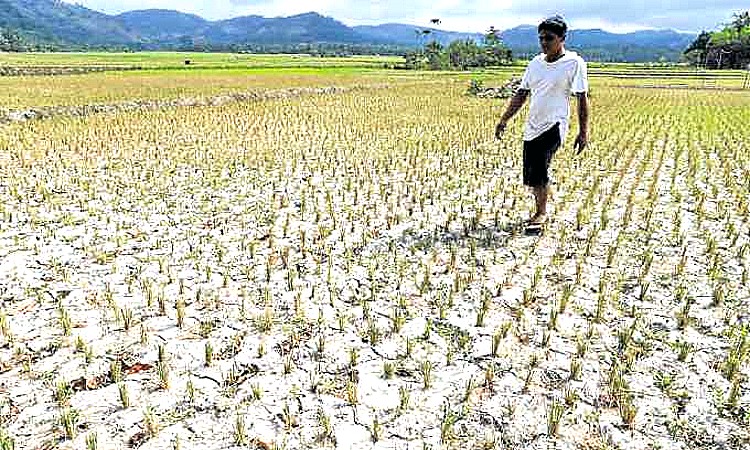The Philippine Atmospheric, Geophysical, and Astronomical Services Administration (Pagasa) predicted as early as May this year that the El Niño weather phenomenon characterized by an extended dry spell may emerge in June and will likely persist until the first quarter of next year.
Because El Niño increases the likelihood of below-normal rainfall conditions that would have a negative impact on people’s health and livelihood, particularly in agriculture, the National Disaster Risk Reduction and Management Council through the Office of Civil Defense (OCD) directed concerned government agencies to prepare and implement necessary measures to minimize its impact.
Unfortunately, it seems that the government did not heed its own advice, as the National Action Plan to mitigate the adverse effects of El Niño has yet to be finalized and the OCD is scheduled to convene the National El Niño Team only on July 19.
“We are looking forward to the finalization of the National Action Plan for El Niño by this team as we continue to undertake various activities specific to our agency mandates to ensure that the effects of El Niño-induced dry spells and drought to the country can be countered,” OCD administrator Undersecretary Ariel Nepomuceno said late last week.
The primary question on Filipinos’ minds is: Why only now?
Where is the sense of urgency considering that the government already knew it was coming months back and the Philippines knows far too well the potentially devastating effects of El Niño, which could become more severe with worsening climate change?
Did the government agencies tasked to prepare for this weather phenomenon wait for Pagasa to officially announce on July 4 the onset of El Niño before springing into action and drawing up a mitigation plan, just when precious time had already been wasted?
Indeed, the effects of this weather phenomenon that occurs every two to seven years are already being keenly felt, with the lack of rain in agricultural areas leading to reduced harvests and therefore raised selling prices, keeping inflation rates at stubbornly high levels.
Pagasa revealed that as of June 30, dry spells — three consecutive months where rainfall was reduced by as much as 60 percent — had already hit Apayao, Kalinga, and Cagayan provinces.
Meanwhile, dry conditions — two consecutive months of a 21-60 percent drop in average rainfall — were also witnessed in the rice-producing provinces of Isabela and Tarlac, which will mean a possible increase in the price of the staple down the road.
Plus, last week, west zone concessionaire Maynilad Water Services Inc. started daily water supply interruptions in its concession area, affecting some 600,000 customers.
In May, when Pagasa started monitoring El Niño more closely, the government could have already mounted a more aggressive campaign to enjoin households and commercial enterprises to conserve water so that the drawdown from Angat Dam, which supplies 95 percent of the water needs of the National Capital Region, could have been slowed down.

Conservation measures may not have prevented Maynilad from altogether avoiding supply interruptions with Angat’s water level dropping to below minimum operating level, but perhaps the extent may be not as long as 11 hours in some of its concession areas.
To think that El Niño is just starting to make its presence felt with its effects expected to strengthen toward a “moderate to severe” degree by the latter part of this year. Bitter experience tells us that even a “mild” El Niño — as expected for this year’s episode — will already have considerable impact.
In 2019, when a “weak” El Niño hit the country, a Department of Agriculture (DA) report showed that damage and losses reached P5.05 billion.
DA reported then that the damage reached P2.69 billion for rice and P2.36 billion for corn, affecting hundreds of thousands of hectares of farmlands. At that time, 42 provinces experienced a dry spell while 22 were hit by drought.
The regular occurrence of El Niño and other natural disasters should have already made preparedness second nature for the Philippines, especially—as experts have long pointed out—that the best time to prepare is when they have not happened yet.
Instead, what happens far too often is planning and action come late in the game, and they are promptly forgotten as soon as the disaster is over.
For example, when it became clear in 2019 that there would be “full-blown” El Niño, the Duterte administration extended discussions of creating a Department of Water to address water supply issues and mitigate effects of El Niño.
There was likewise talk then of interventions such as a campaign to conserve water and energy, plus the installation of water tank systems, establishment of water treatment plants, dredging of waterways, and the streamlined regulation of the country’s water and river basins to ensure adequate water supply for drinking and for irrigation.
The weather phenomenon is back but little progress, if any, had been made on these measures proposed.
These will again be likely listed on the things-to-do when the OCD and other government agencies meet this week.
The question now is whether these will actually be implemented or just another case of a lot of expensive talk and too little action.
ADVERTISEMENT
ADVERTISEMENT








































